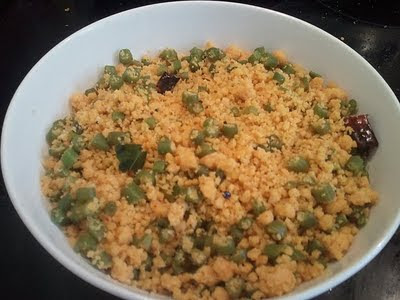I Love Mexican Taco Salad Bowl all the time and my kids love too...Whenever we go to Bajjio or Costa Vida, without even looking at the menu I would order this taco Salad bowl all the time. Its loaded with lots of fresh veggies, cheese, rice, beans, corn roti and this dish has a perfect combination of carbohydrates, protein, calcium and vitamins in it. With a side of a milkshake or cucumber buttermilk, its an excellent combo for all ages. As its very colourful, kids like this variety a lot. Its a good after school lunch or a quick treat for them. Making this Taco Salad Bowl takes very less time. You just have to keep the ingredients ready before making them in place. Though the number of ingredients make you tensed, making this simple salad bowl is not that difficult at all..
Ingredients
Corn Tortilla / Big Tortilla / Wheat Tortilla - 1 ( Of your choice )
Olive Oil - Enough to fry the Tortilla
Mexican Cheese - 3 tbsp
Cooked Sona Masoori Rice - 1/2 Cup
Ripe Tomatoes - Cut into tiny pieces
Coriander Leaves - 1 tbsp nicely shredded
Lemon Juice - Few Drops
Cooked or Baked Red Beans or Black Beans - 2 tbsp
Romaine Lettuce or Lettuce of any kind - 2 Handfuls
Cucumbers - 2 tbsp nicely cut into tiny pieces
Onions - 1 tbsp nicely cut into tiny pieces
Avocado Paste -- 1 tbsp
Ranch or Sour Cream or Thick Curd - 1 tbsp
South Western Sauce or Taco Sauce - 1 tsp
Nacho Chips or Corn Tortilla Chips - 2 tbsp Crushed.
Salt - To sprinkle at the end ( optional )
Pepper - To sprinkle at the end ( optional )
Method
Pre-Preparation
Wash the vegetables and cut the tomato, onion, cucumber, lettuce and coriander leaves into desired shapes and keep them ready. Take one corn tortilla or wheat tortilla and keep it ready. Take a cup of cooked sona masoori rice. Take 2 tbsp of cooked beans or baked beans and keep it on the side. Take out the sauce, ranch,mexican cheese shredded from the fridge and keep them on the side. Keep the salt, pepper shakers on the side too. If you have a ready made lemon juice available, take it out from the fridge or make 1 tsp of fresh lemon juice and keep it ready. Take an avocado and scoop the inside flesh,mash and keep it ready too. NOW, everything is kept ready.
Process
Make the Mexican Rice first.
On a pan, add 1 tsp of Olive Oil. When its heated, add the cooked sona masoori rice, 1 tsp of coriander leaves, little mexican seasoning powder ( if you have ), pinch of salt and fry them on low heat for just 2 minutes.
Make the Avocado paste next.
Scoop the inside part of the Avocado and mash it to a fine paste. Add 1 tsp of coriander leaves, pinch of salt and 2 drops of lemon juice to it.
Make a simple, quick tomato salsa kind next.
On a small bowl, add tiny pieces of tomato, 1 tbsp of coriander leaves, 1 tsp of lemon juice, pinch of salt and pepper and mix them well and mash it little bit.
Fry the Tortilla on both sides with little oil on its sides. Take a sound shaped vessel or any medium size bowl. Insert the fried tortilla on it and make it hollow inside the bowl.
Add shredded mexican cheese on the tortilla while its hot. Chesse would melt nicely on the Top Layer.
Add the 1/2 cup of Mexican Rice on top of the melted cheese.
Add 2 tbsp of cooked / baked beans on top of the rice.
Spread 1 tbsp or more of the tomato salsa made on top of the beans layer. On top of it, add 1 tbsp of tiny cucumber pieces, 1 tbsp of tiny onion pieces. Spread them uniformly on its layer. Add 2 tbsp of Avocado Paste we made on it and spread it across..
Now the cut lettuce leaves and some shredded nacho chips or corn tortilla chips on top of the leaves layer. Add 1 tsp of Taco Sauce or South Western Sauce and spread it across. Add some salt and pepper a little bit using the shakers.
Finally decorate the Taco Salad with few beans, ranch and little shredded cheese and serve it to the kids.
Variations
For more spiciness while serving to elder people, you can add taco hot sauce into it.
You can choose any type of Beans you like and add that into the bowl.
If you don't have sour cream or ranch, you can add 1 tbsp of thick fresh curd on top of the Salad Bowl.
You can add corn, small ripe mango pieces into the salad too. It adds more Mexican flavour and taste to the salad bowl. ( As i don't have them right now, i have not added ).
Tips
Choose a crunchy lettuce which makes the salad bowl more fresh and it does not get soggy quickly.
Try to fry the tortilla to the correct level and not deep fried.
If you have the right ingredients for this recipe,the taste will be amazing.





























